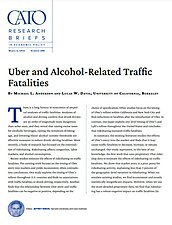There is a long history in economics of empirical analyses of traffic fatalities. Analyses of alcohol and driving confirm that drunk drivers are an order of magnitude more dangerous than sober ones, and they reveal that raising excise taxes for alcoholic beverages, raising the minimum drinking age, and lowering blood-alcohol-content thresholds are effective measures to reduce drunk-driving fatalities. More recently, a body of research has focused on the externalities of ridesharing. Ridesharing affects congestion, labor markets, and alcohol consumption.
Recent studies estimate the effects of ridesharing on traffic fatalities. The existing work focuses on the timing of Uber entry into markets and yields inconsistent, often contradictory conclusions. One study exploits the timing of Uber’s rollout throughout U.S. counties and finds no associations with traffic fatalities or drunk driving, respectively. Another finds that the relationship between Uber entry and traffic fatalities can be negative or positive, depending on the choice of specification. Other studies focus on the timing of Uber’s rollout within California and New York City and find reductions in fatalities after the introduction of Uber. In contrast, one paper exploits city-level timing of Uber’s and Lyft’s rollout throughout the United States and concludes that ridesharing increases traffic fatalities.
In summary, the existing literature studies the effects of Uber’s entry into the market and finds that it may cause traffic fatalities to decrease, increase, or remain unchanged. Our study represents, to the best of our knowledge, the first work that uses proprietary Uber ridership data to estimate the effects of ridesharing on traffic fatalities. We show that market entry is a poor proxy for ridesharing activity, explaining less than 3 percent of the geographic-level variation in ridesharing. When we emulate existing studies, we find inconsistent and mostly statistically insignificant impacts. However, when we use the more detailed proprietary data, we find that ridesharing has a robust negative impact on traffic fatalities (in other words, ridesharing reduces traffic fatalities). Impacts are negative and statistically significant across a range of alternative model designs, and the impacts are larger during nights and weekends, as expected.
We perform several back-of-the-envelope calculations that put our results in context. Scaled up to reflect current ridership levels, our results imply that ridesharing reduces total U.S. alcohol-related traffic fatalities by 6.1 percent and reduces total U.S. traffic fatalities by 4 percent. Based on conventional estimates of the value of a statistical life, the annual life-savings benefits range from $2.3 to $5.4 billion.
Note:
This research brief is based on Michael L. Anderson and Lucas W. Davis, “Uber and Alcohol-Related Traffic Fatalities,” NBER Working Paper no. 29071, July 2021, https://www.nber.org/papers/w29071.

This work is licensed under a Creative Commons Attribution-NonCommercial-ShareAlike 4.0 International License.
